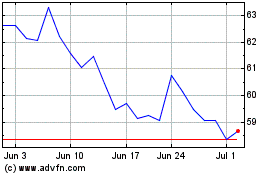By Jennifer Maloney
This article is being republished as part of our daily
reproduction of WSJ.com articles that also appeared in the U.S.
print edition of The Wall Street Journal (August 24, 2017).
Some of the country's biggest craft brewers are struggling with
falling sales, hurt by a glut of competitors crowding retail
shelves and moves by megabrewers to scoop up some of their
rivals.
"It is more competitive than it has ever been," said Ken
Grossman, founder and chief executive of Sierra Nevada Brewing Co.,
the No. 2 U.S. craft brewer by volume.
His company's retail-store sales were off 7.5% this year as of
July 16, according to Beer Marketer's Insights. The brewer's
shipment volumes fell 6.9% in 2016 -- its first decline since
Sierra Nevada was founded in 1980. Just two years ago, the Chico,
Calif., company logged record sales after opening a second brewery
in North Carolina.
After years of strong gains, American craft brewers are now
bracing for a shakeout. Shipments are falling for many independent
brewers stuck in the middle between local niche brands and
competitors that were bought by heavyweights such as Anheuser-Busch
InBev and Molson Coors.
Besides Sierra Nevada, those losing ground include Sam Adams
maker Boston Beer Co., the biggest independent brewer, as well as
smaller producers such as F.X. Matt Brewing Co., which brews
Saranac in upstate New York, and Abita Brewing Co. in Louisiana,
according to Beer Marketer's Insights.
Benj Steinman, president of the tracking firm, said many craft
brewers trying to push into regional and national markets are
finding they hit a wall once they surpass 100,000 barrels. Some
have stretched themselves too thin and lost ground in their home
markets, while others took on too much debt to expand brewing
capacity, brewers said. As they expand, they also lose the cachet
of being a local brand -- something many consumers seek out.
"They used to say a rising tide lifts all boats. And it is
definitely not that now," Mr. Steinman said. His firm estimates
that shipment volumes declined for 16 of the top 36 craft-style
U.S. brewers last year.
The troubles have continued this year. Retail-store sales of
craft-style beers -- from brewers big and small -- fell $143
million to $2.3 billion in the first half of 2017, according to
data from Nielsen. Craft beer shipments grew for years in the
double digits, even as overall beer sales fell. But craft demand
began to decelerate in 2016.
"We really had to put our big boy underpants on and up our
game," said Sam Calagione, founder and CEO of Dogfish Head Craft
Brewery in Milton, Del. The company's volumes were flat in 2016,
but have grown 27% so far this year, he said. "Is it too crowded,
the market? We're almost at the pace of two new breweries a day.
That pace isn't sustainable."
There were 5,562 total breweries in the U.S. as of June 30, up
roughly 900 from the previous June, according to the Brewers
Association.
Shipments are still rising for many of those craft brewers that
sold themselves to industry heavyweights, including Lagunitas,
which was bought by Heineken in May; Goose Island, owned by AB
InBev since 2011; and Ballast Point, which was purchased by
Constellation Brands Inc. for $1 billion in 2015. Those brands
benefit from their parent companies' distribution networks, capital
and marketing.
Earlier this month, Constellation, which distributes Corona in
the U.S., expanded its push into the craft beer market, acquiring
South Florida's small Funky Buddha Brewery for an undisclosed
amount. The microbrewery, which had 30% volume growth so far this
year, was looking to expand distribution beyond Florida and start
production in cans. Those moves would have required a capital
investment of between $6 million and $8 million, its founders said
in an interview.
"Local is still growing, and the larger ones are having
problems," co-founder Ryan Sentz said. "We saw that as a potential
roadblock in the future. We knew that aligning ourselves with a
partner would be exponentially easier."
Microbreweries like Funky Buddha continue to grow fast: The
5,000 small brewers shipping fewer than 100,000 barrels a year had
an average volume growth last year of 14%, double the growth rate
for the craft category overall, according to Beer Marketer's
Insights.
Dogfish Head, Saranac, Abita and other brewers grappling with
soft sales say they are cutting costs, spending more on marketing
and speeding up the launch of new products. Some are trying to
attract fans of whiskey, wine or margaritas with beers aged in
casks, infused with grapes or flavored with limes.
After a January product recall, Sierra Nevada is getting "back
on track, " Mr. Grossman said, with increased marketing and an
accelerated program for testing new products. Those experimental
brews are often released first through the company's tasting rooms
or its rare-beer club.
Boston Beer recently surprised analysts with second-quarter
results that showed sales declines had moderated; shipments to
retailers fell 3%, after a 14% drop in the first quarter. To regain
ground, executives say the company is cutting costs and pitching
its products -- including cider and hard tea -- to younger and more
diverse consumers.
"When the growth stopped, we had overbuilt," Boston Beer's chief
executive, Martin Roper, said in an email. "Our first reaction was
to wait to see if we could grow again...so it was a little bit of
denial about the new flat-to-negative trends continuing."
Write to Jennifer Maloney at jennifer.maloney@wsj.com
(END) Dow Jones Newswires
August 24, 2017 02:47 ET (06:47 GMT)
Copyright (c) 2017 Dow Jones & Company, Inc.
Anheuser Busch Inbev SA NV (NYSE:BUD)
Historical Stock Chart
From Mar 2024 to Apr 2024

Anheuser Busch Inbev SA NV (NYSE:BUD)
Historical Stock Chart
From Apr 2023 to Apr 2024
